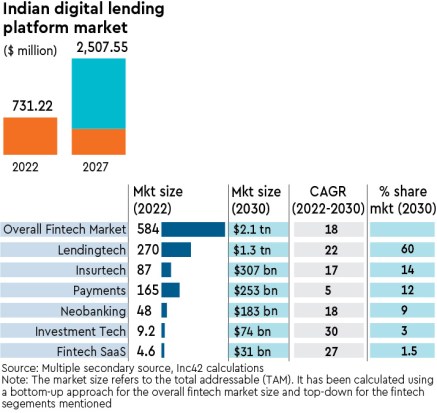The Reserve Bank of India’s (RBI’s) 2022 guidelines on digital lending may cause some disruption for now, but they are expected to provide more clarity to fintech companies. “I believe that most of the changes on the regulatory side have been fairly positive,” co-founder and chief executive officer, Razorpay, Harshil Mathur said, adding that it may cause some disruption in the short term, but “I think in the long term, they are good for customers and good for the eco-system”.
In September, the central bank released the guidelines with an aim to paint a bright-line as far as the activities of digital lenders are concerned.
Also Read: Indian fintechs face a tough 2023 as investments cool, Bain says
In July, RBI governor Shaktikanta Das said that digital lenders must operate under the licences granted to them rather than engaging in activities without permission. Das’ statement followed multiple news reports of harassment, blackmailing and other illegal practices by digital lending companies.
In fact, an RBI working group on digital lending had, in 2021, suggested introducing a separate legislation to curb illegal activities in the space. While the latest guidelines specifically mention banks, non-banking financial companies (NBFCs), digital lending platforms and lending service providers, they impact all kinds of fintech firms.

But the industry believes that the fact the RBI has recognised them as legitimate players is an important first step. For the first time, RBI has acknowledged the presence of certain fintechs or fintech platforms which form a part of a lending service provider or a digital lending app for a regulated entity,” Nageen Kommu, founder and chief executive officer, Digitap, said.
“From that point of view, that is a huge step for the RBI where they have recognised the presence of these fintechs and came up with guidelines of how the KYC validation should be done and how data should be taken from the customers,” he added.
The guidelines also led to the shutting down of illegal Chinese lending applications and brought consumer interests to the fore. However, they indicate a preference towards regulated entities like banks and non-bank lenders that do digital lending instead of pure-play digital lending platforms, thereby inconveniencing the latter, say experts.
For instance, the guidelines ask regulated entities to ensure that any fees, charges payable to various lending service providers are paid directly by them and are not charged by the lending service provider to the borrower directly.
Also Read: What is in store for Fintech users in 2023?
“It (RBI) has not been happy with the pure-play platforms because they have not been under the supervision of the regulator and what not. That has come very clear in the guidelines,” says Madhusudan Ekambaram, chief executive officer and co-founder, KreditBee.
“The pure-play platform companies have been forced to look for an NBFC licence, come under the supervision of the regulator and operate. In the long term, the guidelines are very stabilising. But definitely there have been some short-term pains in the market,” he added.
Additionally, ambiguity on various aspects of first-loss default guarantee (FLDG) has left digital lenders scratching their heads.
Simply put, a first-loss default guarantee is an agreement wherein a third party agrees to compensate up to a certain percentage of default in the lender’s loan portfolio.
FLDG agreements has been popular among fintechs, who want to partner with banks to target borrower segments that traditional lenders do not cater to like freelancers and micro-businesses, among others.
What fintechs want
“..any form of regulation must explicitly state what is permissible, and to the extent possible, clarify what is non-permissible. Ambiguity – such as in the currently in the case of FLDG partnerships – creates confusion and a divergence of views in the ecosystem,” says Aditya Kumar, co-founder and chief executive officer, Niro.
“Beyond this, my ask would be for the RBI to continue to take a consultative, customer-protection first view of regulations, ensuring innovation is not stifled,” he added.
Besides FLDG, there is a need for more clarity on the nature of data that lenders can obtain from customers for underwriting purposes and how this data can be used.
Also, there must be a white-listing of authorised digital lending platforms for borrowers to take informed decisions, says U GRO Capital chief legal and compliance officer Sunil Lotke.
Nevertheless, experts acknowledge that the digital lending rules have been a step in the right direction as far as the financial technology industry is concerned as it has brought finctechs within the ambit of regulatory compliance.
Going ahead, 2023 could see the formation of more self-regulatory organisations, which will lead regulated entities to drive more accountability for consumer rights, say experts. In the days to come, fintechs are confident that the central bank will issue prudential and operational norms for governing digital lenders.
“Looking ahead to 2023, we are confident that the digital lending sector will witness robust growth. This is aided by rising per capita income, greater inclusivity of formal finance, and increased internet penetration in rural areas,” Souparno Bagchi, chief operating officer, Balancehero India, said. “With tools like sandboxes, incubators, and evolved India Stack solutions, we expect to help the co-creation efforts of businesses and regulators as the technology and product side of the fintech industry expands.”

